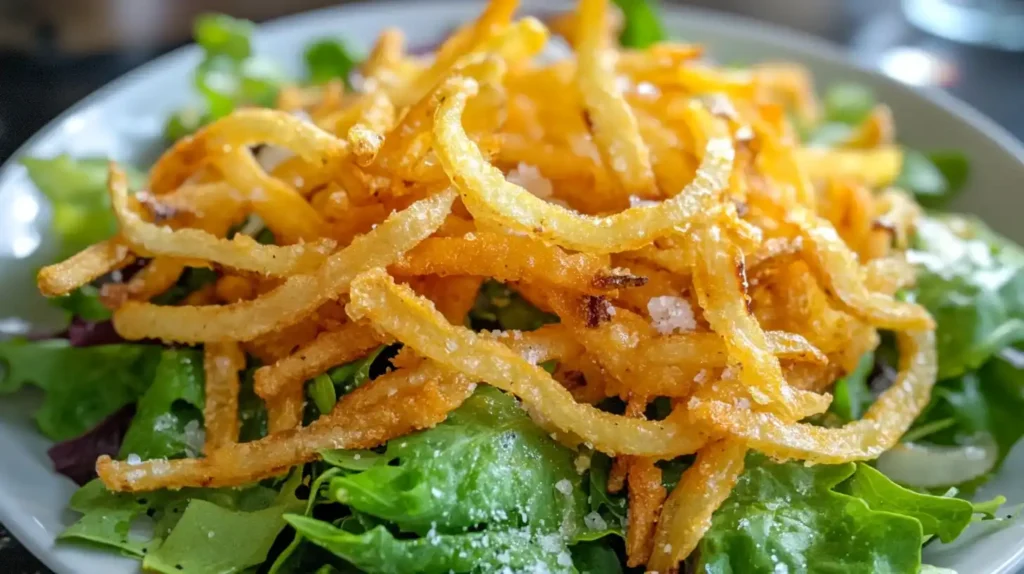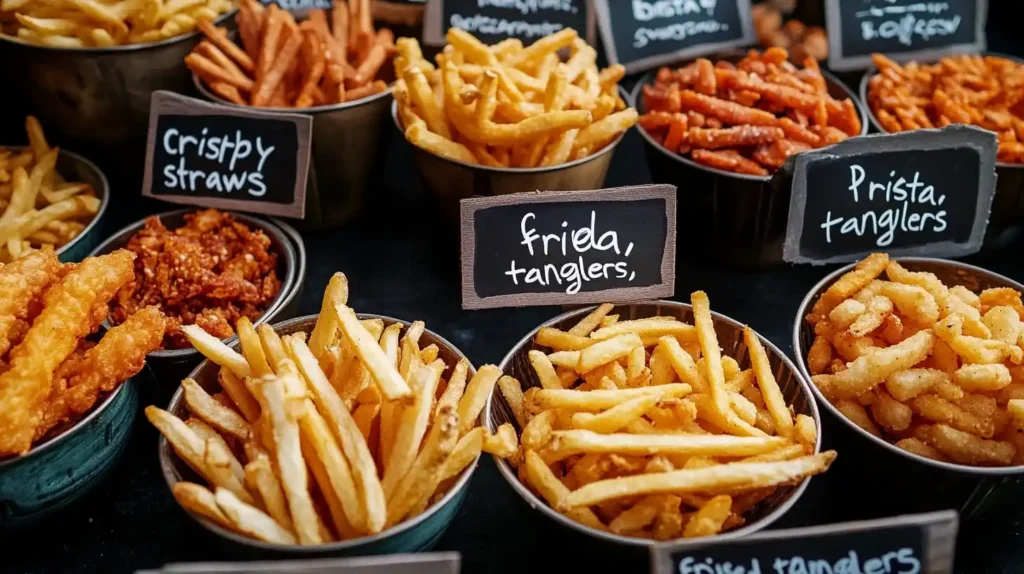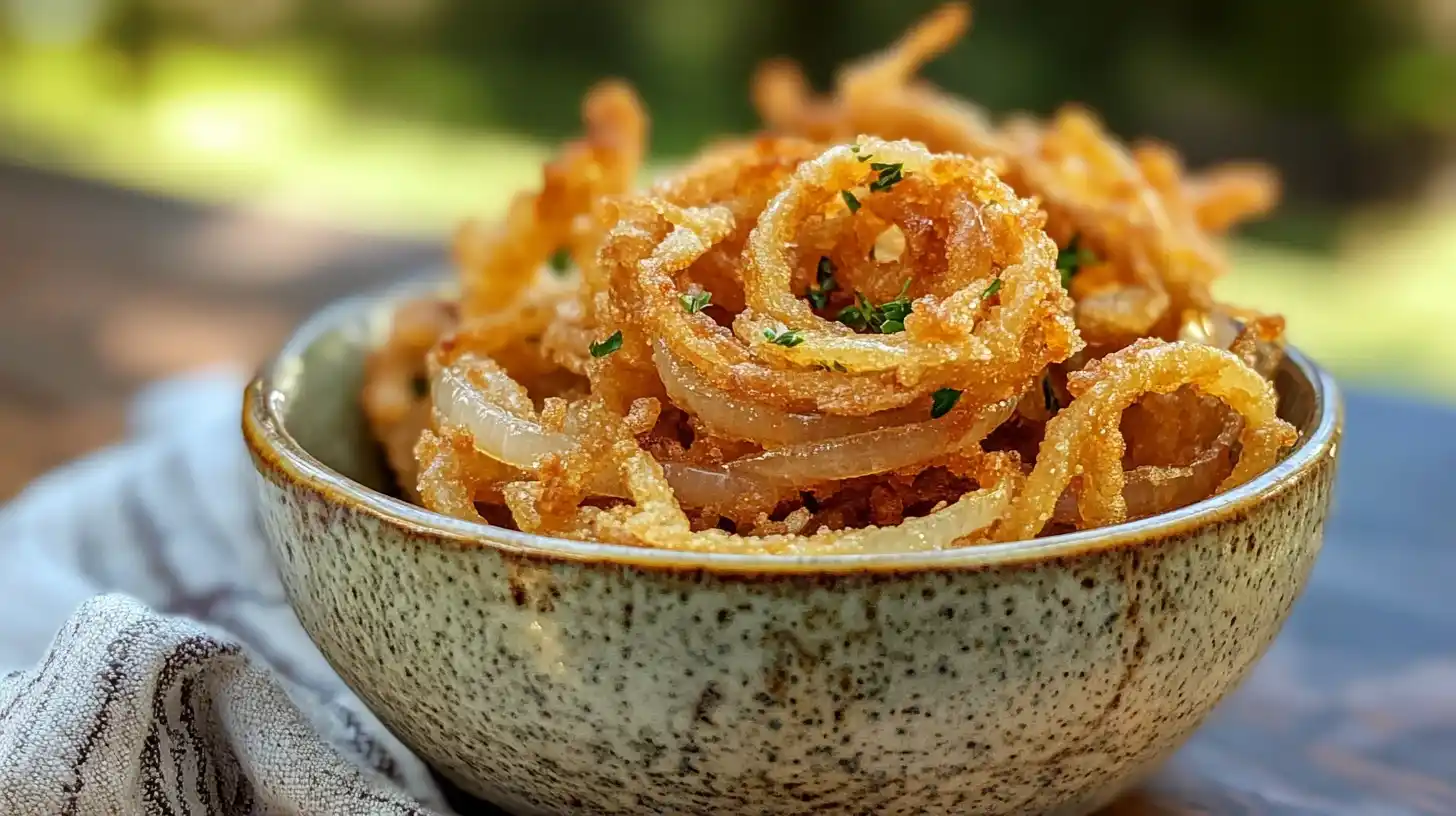Onion fries, often referred to as crispy onion straws or fried onion tanglers, are loved for their irresistible crunch and versatility. These thinly sliced, battered, and deep-fried onions are enjoyed worldwide in many dishes. Whether used as a snack, a topping, or a festive garnish, they bring flavor and texture to every meal.
For a detailed recipe to try at home, you might enjoy this guide on mouthwatering onion French fries.
Interestingly, onion fries are known by different names across cultures. In South Asia, they are called birista and often top festive dishes like biryani. In the U.S., people use them to garnish casseroles, burgers, and salads. To learn how to make them at home, check out this detailed guide.
Table of contents
Where Do Onion Fries Come From?
Onion fries have been around for over a century. They began as a simple garnish or topping, but over time, they became a popular snack. Their rise in popularity is linked to how easy they are to make and how delicious they taste.
- Where It All Began: The term French-fried onions appeared in the early 20th century. It referred to the method of frying the onions in hot oil. The “French” part doesn’t mean they come from France—it’s about the cooking technique.
- How They Spread: Over the years, onion fries became a favorite worldwide. In South Asia, they are called birista. People use them in festive dishes like biryani and stews. In the U.S., crispy onion straws are common toppings for comfort foods like casseroles and burgers.
- Modern Popularity: Today, onion fries are part of fast food and home cooking. Their crunchy texture makes them perfect for salads, sandwiches, and snacks. Fast-food chains also include fried onion tanglers in burgers, making them a must-have ingredient.
Names and Variations of Onion Fries
People all over the world enjoy onion fries, but they call them by different names. These variations reflect local traditions and tastes while keeping the core idea the same.
- In the United States: Many people know them as crispy onion straws. Restaurants often serve these thin, fried strips as a topping for salads and burgers or as a side dish with dips. Their crunchy texture makes them a popular addition to casual dining menus.
- In South Asia: People refer to onion fries as birista. Home cooks and chefs use these golden, crispy onions to enhance the flavor of traditional dishes like biryani and curries. They bring a sweet and savory crunch to meals, which adds depth to the overall taste.
- On Fast-Food Menus: Restaurants often feature them as fried onion tanglers. Customers enjoy them in sandwiches and burgers or as a standalone snack with flavorful sauces.
Clearly, no matter the name, crispy onion fries deliver an irresistible crunch and flavor. Moreover, their adaptability to different cuisines has made them a global favorite.
How to Make Crispy Onion Fries
Making onion fries at home is easy and fun. With just a few simple ingredients and steps, you can create a batch of delicious, golden fries.
Ingredients You’ll Need
To make crispy onion fries, gather the following ingredients:
- Onions (yellow or red work best for flavor).
- Flour, cornstarch, and spices (like paprika, garlic powder, or salt) for the batter.
- Cooking oil for deep frying.
Step-by-Step Instructions
- Prepare the Onions: Slice the onions thinly and separate the layers into rings or strips. This helps them cook evenly.
- Mix the Batter: Combine flour, cornstarch, and your chosen spices in a bowl. Gradually add water to create a smooth, thick batter.
- Coat the Onions: Dip the onion slices into the batter, ensuring they are evenly covered.
- Heat the Oil: Warm the oil in a deep frying pan to about 350°F (175°C). Proper oil temperature ensures crispy results.
- Fry the Onions: Fry the onions in small batches to prevent overcrowding. Cook them until they turn golden and crispy.
- Drain and Serve: Remove the onions from the oil and place them on paper towels to drain excess oil. Season immediately and serve hot.
Pro Tips for Extra Crispiness
- Use cold water or even sparkling water in the batter for a lighter texture.
- Fry the onions twice if you want them to be extra crispy.
- Always season them while they’re still hot for the best flavor.
Creative Ways to Use Onion Fries
Onion fries are incredibly versatile. You can use them as a snack, a topping, or even an ingredient in more elaborate recipes. Their crispy texture and savory flavor enhance almost any dish.
As Toppings
- Sprinkle onion fries over casseroles to add a crunchy layer.
- Use them to garnish steaks or salads for an extra burst of flavor.
- Add them to pasta dishes for a delightful twist.
As Snacks
- Serve onion fries on their own as a quick appetizer.
- Pair them with dips like garlic aioli, spicy chutney, or even plain ketchup for a simple yet delicious treat.
- Offer them as a side dish with burgers or sandwiches for a complete meal.
In Fusion Dishes
- Mix them into loaded fries along with cheese and sauces.
- Incorporate them into wraps or tacos for a creative crunch.
- Add them to gourmet burgers for a restaurant-style experience at home.

Why They Work So Well
Onion fries are not only flavorful but also adaptable. Their crispiness complements soft or creamy dishes, creating a balanced texture. They’re also easy to prepare in large batches, making them perfect for gatherings or parties.
The Science Behind the Perfect Onion Fry
Creating the perfect onion fry isn’t just about the recipe it’s also about understanding the science behind it. Here’s how key elements like batter, oil, and onions themselves play a role in delivering the perfect crunch.
The Role of Onions
Onions contain natural sugars, which caramelize when exposed to heat. This caramelization gives onion fries their golden color and slightly sweet flavor. Additionally, the water content in onions helps steam them from the inside, keeping them tender while the outer layer crisps.
- Best Types of Onions: Yellow onions are the most commonly used because of their balance between sweetness and acidity. Red onions are also a great choice for a slightly sharper flavor.
The Science of Batter
The batter acts as a protective coating for the onions, preventing them from burning and ensuring even browning. The combination of flour and cornstarch in the batter creates a light and airy texture.
- Why Add Cornstarch? Cornstarch absorbs moisture and helps create a crispier crust. It also reduces gluten formation, keeping the coating light.
- Bubbles for Crispiness: Using sparkling water or soda in the batter introduces bubbles, which expand when heated, making the fries even crispier.
Oil Temperature and Its Importance
The oil temperature is crucial to achieving the perfect fry. If the oil is too cold, the onions absorb more oil and become greasy. If it’s too hot, the outside burns before the inside is fully cooked.
- Ideal Temperature: Frying at 350°F (175°C) ensures that the onions cook evenly while the batter crisps up perfectly.
- How to Maintain the Temperature: Fry in small batches to avoid lowering the oil temperature and monitor with a thermometer for accuracy.
Double Frying for Extra Crunch
Double frying is a technique many chefs use to maximize crispiness. The first fry cooks the onions, and the second fry, at a slightly higher temperature, crisps the coating.
- How It Works: During the first fry, the moisture in the onions evaporates. The second fry seals the outer layer, making it crunchier and more durable.
Why the Right Balance Matters
When all these elements onions, batter, and oil work together, you get onion fries that are crispy on the outside, tender on the inside, and packed with flavor.
Healthier Alternatives for Making Onion Fries
While traditional onion fries are deep-fried, you can prepare them in healthier ways without sacrificing flavor. Here are some methods and tips for making guilt-free onion fries.
Baking Onion Fries
Baking is a simple and healthier alternative to frying. It reduces the oil content while still delivering a crispy texture.
- How to Bake:
- Preheat the oven to 400°F (200°C).
- Prepare the onions as usual and coat them with batter or breading.
- Spread them evenly on a parchment-lined baking sheet.
- Air-fry for 10–15 minutes, shaking the basket halfway for even cooking.
- Why It’s Healthier: Baking uses minimal oil, which lowers the fat content significantly. It’s perfect for those looking to cut calories without missing out on the crunch.
Air-Frying Onion Fries
Air fryers are another excellent option for healthier onion fries. This method uses hot air circulation to crisp up the onions with little to no oil.
- How to Air-Fry:
- Preheat the air fryer to 375°F (190°C).
- Lightly spray the onions with oil after coating them.
- Air-fry for 10–15 minutes, shaking the basket halfway through to ensure even cooking.
- Benefits of Air-Frying: You get the same crispy texture with up to 75% less fat compared to deep frying. Plus, it’s quicker and easier to clean up.
Tips for Lightened-Up Onion Fries
- Use whole-grain flour or almond flour for the batter to add nutrients.
- Skip heavy breading and opt for a light dusting of flour or cornstarch.
- Season with herbs and spices instead of salt to keep sodium levels in check.
These healthier options allow you to enjoy onion fries without worrying about excess oil or calories. They are ideal for family meals or gatherings where everyone can indulge guilt-free.
Frequently Asked Questions About Onion Fries
Here are answers to some of the most common questions people have about onion fries. These FAQs will help clarify what makes them special and how you can enjoy them.
What Are Onion Fries Called in Other Cultures?
In South Asia, they are known as birista. These are thinly sliced onions fried until golden brown, often used in traditional dishes like biryani. In the U.S., they are typically called crispy onion straws or fried onion tanglers. Despite the different names, they all share the same delicious concept.
How Are Onion Fries Different From Onion Rings?
Onion fries are thinner, crispier, and often more flavorful. They are usually sliced into thin strips or small pieces, while onion rings are larger and breaded in thicker batter. Onion fries are better suited for toppings, while onion rings are often served as standalone appetizers.
Can you bake onion fries instead of frying them?
Yes, you can! Baking is a healthier alternative. Coat the onions as usual, then spread them on a baking sheet lined with parchment paper. Bake them at 400°F (200°C) for 20–25 minutes, flipping halfway through to ensure even crispiness.
Are Onion Fries Gluten-Free or Vegan?
Yes, they can be. To make them gluten-free, simply use gluten-free flour or cornstarch for the batter. For a vegan option, skip any dairy-based coatings and stick to plant-based ingredients.
Why Do Onion Fries Taste Sweet?
Onions contain natural sugars, which caramelize when fried. This process gives onion fries their slightly sweet, rich flavor. The batter and spices enhance this natural sweetness, making them even more enjoyable.
Fun Facts About Onion Fries
Onion fries have a rich history and some interesting trivia associated with them. Here are some fun facts that you might not know:

1. The Term “French-Fried” Isn’t About France
The term French-fried refers to the method of frying in hot oil, not the country of origin. It describes a cooking technique, similar to how French fries are prepared.
2. They’re Essential in South Asian Cuisine
In South Asia, birista is a must-have ingredient for festive dishes like biryani. It adds both flavor and a crispy texture to the dish, making it more indulgent.
3. Fast-Food Chains Made Them Famous
Fast-food restaurants popularized fried onion tanglers by adding them to burgers and sandwiches. Their crunch and flavor make them a customer favorite.
4. They Can Be Made Ahead
Onion fries can stay fresh for days if stored properly. Many people make large batches, especially for dishes like biryani, where birista is a key topping.
5. They’re a Great Alternative to Chips
Because of their crunch, onion fries are often used as a substitute for chips in dips or snacks. They’re lighter and more flavorful, making them a unique option.
Conclusion
Onion fries, whether called crispy onion straws or birista, are loved for their crunch and flavor. They’re easy to prepare and versatile enough to complement almost any dish. Whether you make them at home or enjoy them as a topping, these golden bites never fail to impress. Why not try them today and add a delicious crunch to your favorite meals?

